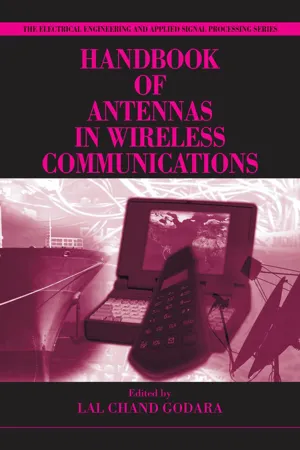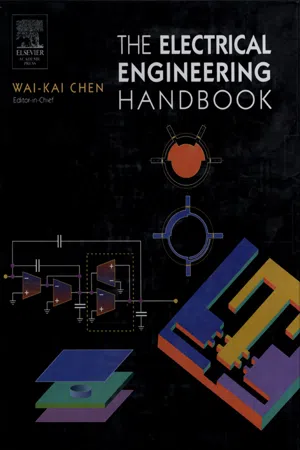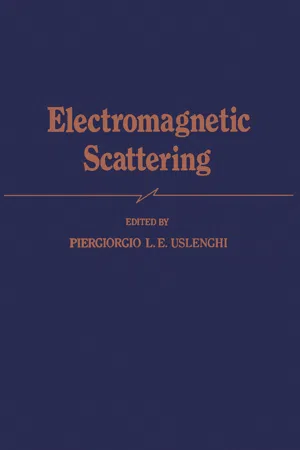Technology & Engineering
Method of Moments
The Method of Moments is a mathematical technique used to estimate parameters of a probability distribution by equating sample moments to theoretical moments. In engineering, it is often applied in the analysis of electromagnetic fields and antennas. This method provides a practical way to solve complex problems by simplifying them into a series of equations based on moments.
Written by Perlego with AI-assistance
Related key terms
1 of 5
6 Key excerpts on "Method of Moments"
- David B. Davidson(Author)
- 2005(Publication Date)
- Cambridge University Press(Publisher)
4 A one-dimensional introduction to the Method of Moments: thin-wire modelling 4.1 Introduction The Method of Moments – MoM – was one of the first numerical methods to achieve widespread acceptance in electronic engineering for the analysis of an- tennas and scatterers. It is generally defined as a method for reducing an integro- differential equation to a set of linear equations. The origins of the method are old; as was already indicated in Chapter 1, some of the early work was done over a century ago. One of the widely used integral equation formulations still used for the analysis of thin wires (that due to Pocklington) was first presented in 1897 (although he used a series expansion method, rather than the modern segmenta- tion approach). The first publications in the antenna and propagation professional literature were in the early 1960s, and some of the canonical papers (those of Harrington, Richmond, Mei and Andreasen) appeared at much the same time as Yee’s paper. The specific name “Method of Moments” was introduced by Harrington in his early work, and the name caught on quickly; this was perhaps unfortunate, since the name has a slightly different meaning in contemporary ap- plied mathematics. In that field, and also fields such as computational mechan- ics, the term “method of weighted residuals” is generally used for what has be- come known as the MoM in radio-frequency engineering. Another term widely used in other fields of engineering is “boundary element method”; for highly conducting structures, this term and the MoM as used in electromagnetics are synonymous. 1 Primarily for two reasons, the MoM rapidly achieved widespread acceptance.- eBook - ePub
- Levent Sevgi(Author)
- 2014(Publication Date)
- Wiley-IEEE Press(Publisher)
CHAPTER 13 Method of MomentsMethod of Moments (MoM) is a numerical technique used to approximately solve linear operator equations such as differential equations or integral equations. The unknown function is approximated by a finite series of known expansion functions with unknown expansion coefficients. The approximate function is substituted into the original operator equation and the resulting approximate equation is tested so that the weighted residual is zero. This results into a number of simultaneous algebraic equations for the unknown coefficients. These equations are then solved using matrix calculus. MoM has been used to solve vast number of electromagnetic (EM) problems during the last five decades.13.1 Introduction
Method of Moments is a general procedure for solving linear equations. Many problems that cannot be solved exactly can be solved approximately by this method.For example, consider the simple problem of the parallel plate capacitor. The approximate analytical formula for the capacitance is C0 = εA/d, where A is the area of each plate and d is the distance between them. This formula neglects the fringing fields and is inaccurate except for very small d. In a later section, we use MoM to compute more accurate capacitance (including the fringing effects) for arbitrary d. Figure 13.1 shows the computed capacitance C normalized to C0 given earlier. The figure shows the limitation of C0 even for quite small values of d.Figure 13.1. Normalized capacitance of the parallel plate capacitor versus plate distance, simulated with MoM (plates are identical and square with width = length = 2a).The MoM owes its name to the process of taking moments by multiplying with appropriate weighing - eBook - ePub
- Lal Chand Godara(Author)
- 2018(Publication Date)
- CRC Press(Publisher)
8 Method of Moments Applied to Antennas Tapan K. Sarkar Syracuse University Antonije R. Djordjevic University of Belgrade Branko M. Kolundzija University of Belgrade 8.1 Introduction 8.2 Maxwell’s EquationsBasic Equations, Constitutive Relations, and Boundary Conditions • Phasor Representation and Equations in Complex Domain • Lorentz Potentials and Green’s Function8.3 Method of MomentsLinear Operator Equations • Basic Steps of the Method of Moments • Formulation of Integral Equations8.4 Antenna AnalysisIntroduction • Wire Antennas • Metallic (Surface) Antennas • Metallodielectric Antennas8.5 Conclusion 8.1 IntroductionThe art of the electrical engineering design partly relies on the ability to properly model the physical structure under consideration. Good models enable an efficient and accurate analysis, so that designers can reach their goals with a few iterations on the models and, usually, a few steps of experimental verification.Most electrical and electronic engineers use circuit-theory models to analyze various passive and active circuits. Such models are simple and straightforward to implement, they do not require bulky theoretical background, and they are easy to visualize. However, they may fail to predict circuit behavior even at power frequencies, let alone analyze radiation phenomena. Let us not forget that the circuit-theory models need a link to the physical structure they represent to provide meaningful results. For example, we need to know how to evaluate the resistance of a wire in order to represent it by a resistor.Electromagnetic field models are predominantly used by antenna and microwave engineers. The analysis starts from the physical structure (i.e., the geometry and electrical properties of materials involved), and it gives a full insight into the properties of devices and circuits (including propagation, radiation, parasitic effects, etc.). Most electromagnetic field problems do not have an analytic solution and a numerical approach is required. However, writing a computer code for the solution of a class of problems is a hard task. Even to properly use codes for the electromagnetic field analysis, a lot of background and experience is required. This software is usually very sophisticated, it covers only a narrow region of applications, and it may sometimes require a long central processor unit (CPU) time to produce results. - eBook - PDF
- Warren L. Stutzman, Gary A. Thiele(Authors)
- 2012(Publication Date)
- Wiley(Publisher)
14-1. 588 Chapter 14 CEM for Antennas: The Method of Moments When a problem is large in terms of the wavelength, full-wave methods become less attractive because calculating the unknown currents or fields requires solving a very large system of linear system equations or marching fields through a very large number of time steps. This can put excessive demands upon computer resources. For such problems, high-frequency methods provide a reasonable alternative (see Fig. 14-2). High-frequency methods can be either field based or current based (see Fig. 14-1). Field-based methods use ray optics to account for the reflection, refraction, and diffraction of electromagnetic fields. Current-based methods start with a basic assumption about the relationship between the current and the surface fields and then integrate over the current, and possibly its refinements, to obtain the radiated field. In high-frequency methods, there is no need to solve for the unknown currents or fields on the antenna or scatterer as is required in full- wave methods, and therefore computer resources are often less of an issue. On the other hand, we note that some high-frequency current-based simulations require tens of thousands of facets on the radiating object because of its electrical size, resulting in a very large problem to be simulated. There are many techniques for modeling radiation problems. The following sections of this book in Chaps. 14, 15, and 16, will examine four representative techniques in detail. These are: 1. Method of Moments (MoM) 2. Finite difference time domain (FDTD) 3. Geometrical optics (GO) with the uniform theory of diffraction (UTD) 4. Physical optics (PO) with the physical theory of diffraction (PTD) These are not the only techniques in use today, but they probably represent the ones most commonly used, other than the popular finite element method (FEM). There are many FEM books, several of which are directed toward antennas [H.10.5: Volakis; H.10.5: Jin]. - eBook - ePub
- Wai Kai Chen(Author)
- 2004(Publication Date)
- Academic Press(Publisher)
After the establishment of Maxwell’s theory in 1873, the early electromagnetics analyses were associated with such simple shapes as spheres, cylinders, and planes. As the scientific and engineering demand for sophistication rose, solutions to more complex geometries were needed. As a result, approximate techniques were developed to solve Maxwell’s equations. One can view circuit theory as a reduced form of Maxwell’s theory in the low-frequency limit where approximate analyses of many complex geometries have been obtained with astounding success. At the other end of the spectrum, highfrequency ray theory, diffraction theory, and perturbation theory were developed to provide approximate solutions to Maxwell’s equations. Recently, with the advent of computer technology, numerical methods were developed in the 1960s to allow more versatility and accuracy in the solution methods.The Method of Moments, also known as the moment method, is one of the numerical methods developed to rise up to the challenge of solving increasingly complex problems in electromagnetics. It transforms the governing equation of a boundary-value problem into a matrix equation to enable its solution on a digital computer. Although the basic mathematical concepts of the moment method were in existence during early 20th century, true interest in it did not arise until the mid-1960s, with the publication of pioneering work by Mei and Van Bladel (1963) , Andreasen (1964) , Oshiro (1965) , and Richmond (1968). The unified formulation of the method was presented by Harrington in his seminal book in 1968. Since then, the method has been further developed and applied to a variety of important electromagnetic problems. It has become one of the dominant methods in computational electromagnetics. It is not our intent here to present a complete history and list of references on the method. The reader is referred to Miller (1992) for a 35-page bibliography of the journal articles from 1960 to 1990. This book also presents a selection of key articles for the analytical formulation, numerical implementation, and practical application of the method. Other books on the topic include the ones by Mittra (1973), Hansen (1990) , Wang (1991) , andPeterson et al. - eBook - PDF
- Piergiorgio Uslenghi(Author)
- 2012(Publication Date)
- Academic Press(Publisher)
ELECTROMAGNETIC SCATTERING MOMENT-METHOD TECHNIQUES IN ELECTROMAGNETICS FROM AN APPLICATIONS VIEWPOINT Ι-Ε. K. Miller and A. J. Poggio Lawrence Livermore Laboratory The various issues of concern in the practical application of Moment-Method techniques in electromagnetics are discussed. Special attention is devoted to the steps involved in the develop-ment and use of a computer model. Ά survey of the state-of-the-art in connection with problem types most often encountered is also given. Ά recommendation is made for a methodological framework to be developed for EM problem solving to more effectively exploit analytical, computational and experimental procedures. I. INTRODUCTION AND SUMMARY There has been a literal explosion in the use of computer-oriented techniques in electromagnetics over the past decade. Of course, computations have always had a place in obtaining results for the classical problems of EM, for example, the Mie series for the sphere. Such problems presented relatively simple computa-tional requirements, however, and could be evaluated using desk calculators, an approach which lasted into the I960 1 s. The in-creasing power and availability of the digital computer have not only replaced such burdensome methods, but have vastly expanded the repertoire of EM problem solving. Of particular importance in this regard has been the role of ^This work was performed under the auspices of the U.S. Energy Research and Development Administration under contract number W-7405-ENG-48. 315 Copyright © 1978 by Academic Press, Inc. All rights of reproduction in any form reserved. I S B N 0-12-709650-7 316 Ε.K. Miller and A.J. Poggio integral-equation formulations and their numerical treatment via the Method of Moments (MoM). While the first published numerical results of MoM EM solutions occurred only as recently as the mid 60's, they have already come to occupy a central place in electro-magnetics.
Index pages curate the most relevant extracts from our library of academic textbooks. They’ve been created using an in-house natural language model (NLM), each adding context and meaning to key research topics.





